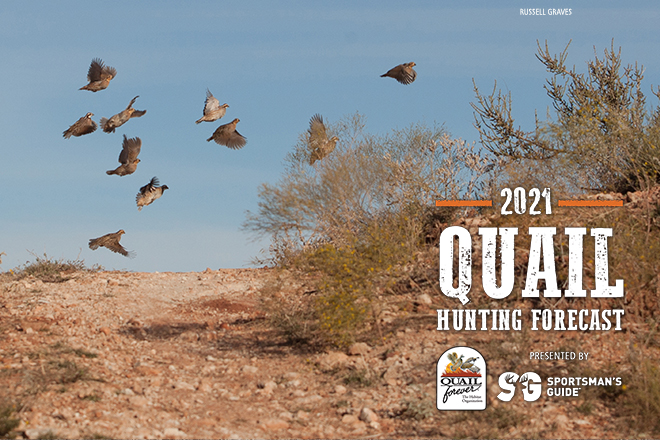
More quail are shot in Texas each year than any other state, and as Lone Star State bird hunters head into fall, conditions look ripe to continue that trend.
WEATHER AND CONDITIONS
Weather, habitat, and rangeland conditions in Texas were good to excellent across most of the state this year,” says John Mclaughlin, upland gamebird program leader with the Texas Parks and Wildlife Department. “These conditions were a result of ample May-June rainfall and for quail, extended, mild temperatures were a welcome reprieve from several hot, dry, summers.”
However, McLaughlin adds, a relatively dry start to the spring delayed early nesting season activity. “So while nesting and brood-rearing conditions were near ideal through summer, we missed out on most of our early production,” explains Mclaughlin. “Those spring broods provide outsized contributions to our fall populations, so not being able to capitalize on those opportunities was unfortunate. This was somewhat offset in South Texas where greater contiguous habitat and higher breeding stock heading into the nesting season provided a buffer.”
HABITAT, BROODS AND COUNTS
“Habitat and rangeland conditions in Texas were good to excellent across most of the state this year,” says Mclaughlin. “It’s been close to five years since Texas looked this good and many of our quail strongholds, including the Rolling Plains and South Texas, have produced some amazing grass and weed cover. Farther west, in the Trans-Pecos, drought like conditions extended into the late spring and while the region received some summer rainfall, quality grass cover remained limited.”
Mclaughlin says that while population numbers are down in many parts of the state outside South Texas, hunters will no doubt note the high quality and quantity of good upland game bird habitat across Texas.
Dustin McNabb, Quail Forever regional representative for Texas, agrees. “Thanks to the mild summer temps and rainfall, habitat is BOOMING!” says McNabb. “It seems like everywhere you look it’s green. Many areas where habitat was naturally degrading bounced back this year and in some cases the birds responded in kind.”
As for hatching and brood success, fewer carryover birds from last year mean fewer broods, but according to Mclaughlin what birds there were, were successful.
“We don’t believe we had much early season production this year up north but once nesting got underway in May, the hens who were out there got to work,” states Mclaughlin. “However, there just weren’t that many birds to start the season and as one of our biologists rightly stated, “one hen can only do so much.”
“If there is good news to be had it’s that temperatures were relatively mild this summer and with ample rainfall we’ve had researchers report nests hatching into mid-September in the Rolling Plains and Cross Timbers. There have also been several reports of hens raising a second brood. While the ability of those chicks to change our hunting forecast is limited, it’s a good sign we may be able to catapult that growth into 2022. As for South Texas, reports boded well for an early start and a long nesting season. We’ve also documented young broods on the ground into September and expect the region had a very productive nesting season.”
Cautious optim,ism is how McNabb is describing brood and nest success this year. “Good weather and an extended brooding season is great news,” says McNabb. “Couple that with birds surviving snowmageddon and we can really get our hopes up, and that’s great. But we also need to understand that brood sizes were smaller, resulting in smaller hatches. This year is setting itself up to resemble 2013, which most quail hunting Texans remember was the lead-in to a TREMENDOUS couple of years to follow.”
TOP SPOTS
“South Texas is the place to be this year,” says Mclaughlin. “While public lands are limited in that part of the state (Chaparral WMA; James E. Daughtrey WMA), hunting on private lands should be productive. If you know someone in the region east of I-35, in the areas known as the Sand Sheet (e.g., Kleberg, Kenedy Counties), now would be a good time to reach out. We also expect good hunting in the counties west of I-35 out to Del Rio.”
McNabb echoes those sentiments. “South Texas still appears to hold the title again this year. I have heard good reports of quail, especially blues out in west Texas, the closer you get to New Mexico the better. I have personally seen good bird counts all through the panhandle and southern high plains, but be prepared to knock on doors to gain access.”
INSIDER TIP
“Because of the variability in Texas quail populations this year, reaching out for local knowledge will be key to success,” says Mclaughlin. “We have wildlife biologists who cover every county of the state and reaching out to them would help give folks some perspective, especially at it relates to local conditions and opportunities. Their
contact info can be found on our website. It’s worth noting that while our survey numbers were low across the board, those surveys are only meant to give an idea of populations at the regional level. Time and time again we’ve seen select counties and local ranches buck those trends. So again, calling ahead for some advice and insights is highly recommended.”
“Grab a friend, put some new tires on the pick-up and put some miles in,” says McnNabb. “Texans are pretty friendly people, so don’t hesitate to stop in at the local café or co-op and introduce yourself. And if you do gain access to a spot, leave it better than you found it… you’ll likely get access next year.”